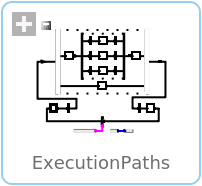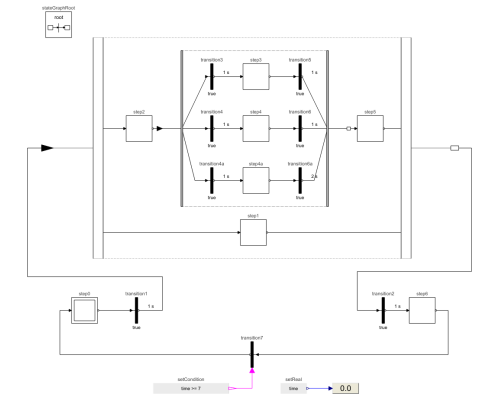WOLFRAM SYSTEM MODELER
ExecutionPathsExample to demonstrate parallel and alternative execution paths |
|
Diagram
Wolfram Language
SystemModel["Modelica.StateGraph.Examples.ExecutionPaths"]

Information
This information is part of the Modelica Standard Library maintained by the Modelica Association.
This is an example to demonstrate in which way parallel activities can be modelled by a StateGraph. When transition1 fires (after 1 second), two branches are executed in parallel. After 6 seconds the two branches are synchronized in order to arrive at step6.
Before simulating the model, try to figure out whether which branch of the alternative sequence is executed. Note, that alternatives have priorities according to the port index (alternative.split[1] has a higher priority to fire as alternative.split[2]).
Components (23)
| step0 |
Type: InitialStep Description: Initial step (= step that is active when simulation starts) |
|
|---|---|---|
| transition1 |
Type: Transition Description: Transition where the fire condition is set by a modification of variable condition |
|
| step1 |
Type: Step Description: Ordinary step (= step that is not active when simulation starts) |
|
| transition2 |
Type: Transition Description: Transition where the fire condition is set by a modification of variable condition |
|
| step6 |
Type: Step Description: Ordinary step (= step that is not active when simulation starts) |
|
| step2 |
Type: Step Description: Ordinary step (= step that is not active when simulation starts) |
|
| transition3 |
Type: Transition Description: Transition where the fire condition is set by a modification of variable condition |
|
| transition4 |
Type: Transition Description: Transition where the fire condition is set by a modification of variable condition |
|
| step3 |
Type: Step Description: Ordinary step (= step that is not active when simulation starts) |
|
| step4 |
Type: Step Description: Ordinary step (= step that is not active when simulation starts) |
|
| transition5 |
Type: Transition Description: Transition where the fire condition is set by a modification of variable condition |
|
| transition6 |
Type: Transition Description: Transition where the fire condition is set by a modification of variable condition |
|
| step5 |
Type: Step Description: Ordinary step (= step that is not active when simulation starts) |
|
| setReal |
Type: RealExpression Description: Set output signal to a time varying Real expression |
|
| transition7 |
Type: TransitionWithSignal Description: Transition where the fire condition is set by a Boolean input signal |
|
| setCondition |
Type: BooleanExpression Description: Set output signal to a time varying Boolean expression |
|
| transition4a |
Type: Transition Description: Transition where the fire condition is set by a modification of variable condition |
|
| step4a |
Type: Step Description: Ordinary step (= step that is not active when simulation starts) |
|
| transition6a |
Type: Transition Description: Transition where the fire condition is set by a modification of variable condition |
|
| NumericValue1 |
Type: RealValue Description: Show Real value from numberPort or from number input field in diagram layer dynamically |
|
| alternative |
Type: Alternative Description: Alternative splitting of execution path (use component between two steps) |
|
| Parallel1 |
Type: Parallel Description: Parallel splitting of execution path (use component between two transitions) |
|
| stateGraphRoot |
Type: StateGraphRoot Description: Root of a StateGraph (has to be present on the highest level of a StateGraph) |

